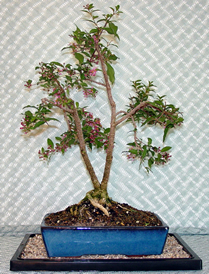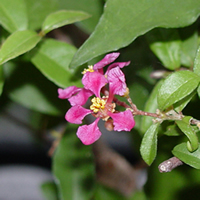Brush Cherries are ideally suited for bonsai. There are many different varieties that are natural dwarfs. These varieties have very small leaves and slow growth habits. Types of Brush Cherries include, Australian Dwarf Brush Cherry, Barbados Cherry, Weeping Barbados Cherry, and 'Teenie Genie' Brush Cherry, to name a few. In the proper conditions some Brush Cherries form a small cream colored ball that later opens into a beautiful starburst bloom. Barbados and Weeping Barbados Cherries form strands of bright pink flowers. Brush Cherries should be kept indoors all year round. With a few simple guidelines your Brush Cherry bonsai can be grown without difficulty. |
 |
| Watering
Brush Cherries, as with most bonsai, like to dry out between waterings. Feel the soil every day. If there is a rock in the planting lift it up and feel under it, otherwise, just stick your finger about a half of an inch to an inch into the soil. If the soil feels dry, water your bonsai. Never let your bonsai go totally dry for extended periods!!! The best way to water your bonsai is to soak it in a sink or container of water up to the trunk for about 5 to 10 minutes. Then allow it to drain. If top watering your bonsai, water, wait a few minutes, and water again. Repeat this several times to insure that your bonsai has received a thorough watering. Eventually you will be able to determine a watering schedule that meets your climate conditions. |
Light
Brush Cherry bonsai grow well in either direct or indirect sunlight. We prefer to grow Brush Cherry in shady areas, out of the hot afternoon sun. Sometimes the direct afternoon sun can burn delicate leaves, especially when shining through a household window. Direct morning sunlight is great for almost all bonsai because of its low intensity.
|
 |
|
Feeding
Fertilize your Brush Cherry bonsai once every two weeks during the growing season, spring until fall. We recommend using an organic liquid fertilizer such as a fish emulsion or an organic seaweed fertilizer. Chemical fertilizers may be used but should be diluted to approximately one half strength so that valuable roots are not damaged. Organic pellets such as rice cakes may also be used along with regular fertilizers.
Humidity
Humidity around your Brush Cherry bonsai may be maintained by the use of a humidity tray or plate filled with stones and water. Your bonsai can be placed on top of the stones in the tray. The tray or plate will also offer protection from the draining water of your freshly watered bonsai. Misting once a day will also help…but remember, misting is not a replacement for watering. |
|
Repotting
Brush Cherries should be repotted about every two years, although they should be checked every year. The best time to repot Brush Cherries is in the early spring. Sometimes Brush Cherries do not react well to extreme root pruning so use caution not to prune roots back too far when repotting. After repotting, water thoroughly and keep the plant in a shady location for several weeks so that new roots may grow. |
Winter Care
Brush Cherries should be kept indoors during the winter months. Display them in a sunny spot that does not go below 55 degrees Fahrenheit.
Moss
Moss is certainly not essential to growing bonsai, but when moss is added to a bonsai it both enhances its beauty and improves moisture retention within the bonsai pot. If your bonsai has moss growing in it you can help to keep it alive by misting it regularly. If the moss dies, you may replace it with some of your own moss from your backyard. |
 |
Endnote
|
These instructions, when followed properly, will help keep your bonsai healthy and beautiful. There are many more publications available that offer more in depth information about your bonsai and we encourage you to read some of them. There are also local bonsai clubs and societies that offer many great learning experiences in the area of bonsai.
We hope you enjoy your bonsai experience as much as we have enjoyed ours. |